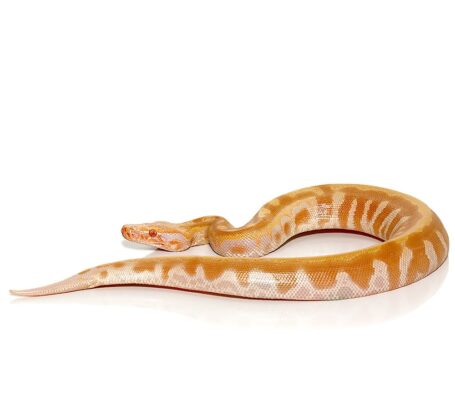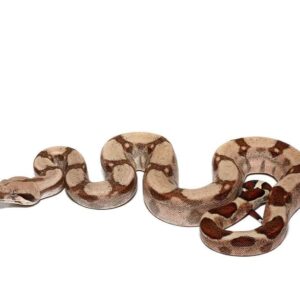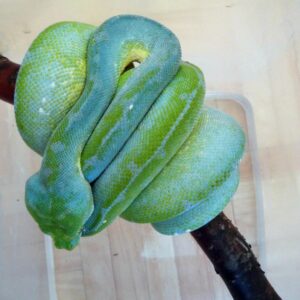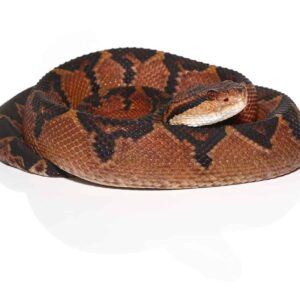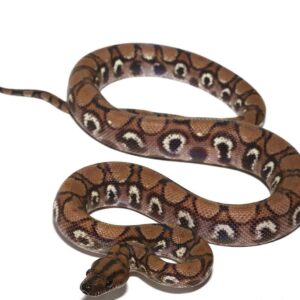Baby T Negative Albino Blood Python
$249.99
WE HAVE BABY T NEGATIVE ALBINO BLOOD PYTHON FOR SALE. HERE ARE SOME HIGHLIGHTS:
- Originating From The Islands Of Borneo And Sumatra In Indonesia
- Adults Will Average In Lengths Around 4-5 Feet
- With Proper Care These Snakes Can Live Up To 20-25 Years At A Time
- Blood Pythons Are Terrestrial Snakes Living Their Lives On The Forest Floor Blending In With The Leaf Litter And Attacking Prey By Surprise
- Python brongersmai
- Captive Bred Babies
- Males Available
- Approximately 16 – 17 Inches In Length
- This Is A Gorgeous Line Of Albino Known For Their Extreme Coloration
- This Species Can Be Feisty But They Tame Down Well With Handling
- Ambush Hunters Feeding On Live And Frozen Thawed Rat Pups Regularly
Description
The T Negative Albino Blood Python, scientifically known as Pythons brongersmai, is a rare and captivating reptile that has garnered significant attention within the herpetological community. This particular morph belongs to the species commonly referred to as Blood Pythons, recognized for their vivid coloration and robust physique. The “T Negative” designation refers to the absence of tyrosinase, an enzyme crucial for melanin production, resulting in a striking albinism that sets it apart from other blood python morphs.
Among the various morphs of Blood Pythons, the T Negative Albino stands out due to its unique genetic mutation, which leads to a lack of dark pigmentation. This results in a visually stunning appearance characterized by a bright yellow and orange coloration, often with distinctive white patterns. The rarity of this morph is a significant factor in its allure; breeders and collectors highly prize these pythons, not only for their beauty but also for the challenges involved in producing them.
In addition to their remarkable appearance, T Negative Albino Blood Pythons exhibit several traits that make them particularly fascinating. These pythons are known for their relatively docile nature compared to other blood python morphs, making them more manageable for experienced reptile keepers. Their stout, muscular build is another noteworthy feature, contributing to their reputation as powerful and resilient snakes. Despite their somewhat intimidating size, these pythons are generally calm and can make rewarding pets for those who are well-versed in snake care.
Overall, the T Negative Albino Blood Python is a remarkable example of genetic diversity within the species. Its distinctive appearance, coupled with its rarity and unique characteristics, make it a highly sought-after morph among reptile enthusiasts. Understanding the origins and traits of this fascinating reptile provides valuable insights into the broader world of herpetology and the ongoing fascination with blood pythons.
Physical Characteristics and Appearance
The T Negative Albino Blood Python stands out in the reptile world due to its distinctive physical characteristics. Lacking melanin, this python exhibits a strikingly unique coloration. Its body is adorned with a palette of bright yellows, oranges, and whites, creating a vivid and eye-catching pattern. This albino morph is particularly noted for its clean and vibrant hues, which contrast starkly with the typically darker shades seen in other blood python morphs.
One of the most captivating features of the T Negative Albino Blood Python is its pattern. The python’s body is marked with irregular blotches and stripes, giving it an almost mosaic-like appearance. These patterns are not only visually appealing but also serve as a distinguishing feature when comparing it to other morphs. For example, while the standard Blood Python generally has a darker, more muted coloration with browns and reds, the T Negative Albino’s bright and light colors make it easily recognizable.
Size-wise, the T Negative Albino Blood Python is consistent with other blood python species. Adult specimens typically range from 4 to 6 feet in length, with some individuals possibly exceeding this range. They possess a robust and muscular build, which is characteristic of blood pythons. Despite their relatively short length compared to other pythons, their girth is quite substantial, giving them a stocky and powerful appearance.
In comparison to other blood python morphs, the T Negative Albino is truly a visual marvel. Its lack of melanin not only alters its color but also enhances the visibility of its intricate patterns, making it a prized specimen among reptile enthusiasts and collectors. The combination of its striking colors, distinctive patterns, and substantial size make the T Negative Albino Blood Python a fascinating and rare reptile that continues to captivate those who encounter it.
Habitat and Natural Distribution
The T Negative Albino Blood Python, a reptilian marvel, thrives in the diverse ecosystems of Southeast Asia. Predominantly, these intriguing serpents are found in regions such as Thailand, Malaysia, and Indonesia. Their natural habitat is characterized by tropical rainforests, swamps, and marshlands, where humidity levels are consistently high. This environmental preference is crucial for the T Negative Albino Blood Python, as it directly influences their physiological and behavioral patterns.
In these lush, verdant habitats, the T Negative Albino Blood Python exhibits a preference for densely vegetated areas and the soft, moist substrates of the forest floor. This choice of environment is not arbitrary; the high humidity and warmth are vital for maintaining their metabolic functions and overall health. Moreover, this natural habitat provides ample cover and hunting grounds, where they can effectively camouflage and ambush their prey.
The geographical distribution of the T Negative Albino Blood Python also plays a significant role in their behavioral adaptations. For instance, these pythons are known to be relatively sedentary, a trait that is advantageous in their swampy, forested habitats. Their behaviors, such as basking and burrowing, are closely linked to the microclimates within their natural range. Basking helps regulate their body temperature, while burrowing provides necessary protection from predators and extreme weather conditions.
Furthermore, the environmental pressures of their habitat have led to the evolution of unique physiological traits. The T Negative Albino Blood Python’s distinctive coloration, for example, serves as an effective camouflage in the dappled light of the forest underbrush. This adaptability ensures their survival and success in the wild, highlighting the intricate relationship between these pythons and their natural surroundings.
Understanding the habitat and natural distribution of the T Negative Albino Blood Python provides valuable insights into their ecological significance and the conservation efforts required to protect these remarkable reptiles. Their reliance on specific environmental conditions underscores the importance of preserving their natural habitats to ensure their continued existence.
Behavior and Temperament
The T Negative Albino Blood Python, a distinctive and rare reptile, exhibits intriguing behavior and temperament patterns that set it apart from other blood pythons. These snakes are known for their relatively sedentary lifestyle, often preferring to spend significant periods in a single location. This low activity level is a notable characteristic and can be attributed to their natural habitat, where they blend seamlessly into the leaf litter of tropical rainforests.
When it comes to feeding habits, the T Negative Albino Blood Python demonstrates a robust feeding response. They primarily prey on small mammals and birds, using their strong constriction abilities to subdue prey. Unlike some other python species that may exhibit picky eating behaviors, these blood pythons are generally reliable feeders. Regular feeding schedules and appropriate prey size are crucial to maintaining their health and well-being.
In terms of interactions with their environment, T Negative Albino Blood Pythons are known for their preference for burrowing and hiding. They often seek refuge in tight, enclosed spaces, which can be simulated in captivity with appropriately sized hides. This behavior underscores their secretive nature and highlights the importance of providing a habitat that mimics their natural surroundings to reduce stress and encourage natural behaviors.
Interactions with other animals, including humans, can vary. While blood pythons, in general, have a reputation for being defensive, the T Negative Albino Blood Python, when handled regularly and gently, can become more tolerant of human interaction. However, they should always be approached with respect and care, as sudden movements or improper handling can elicit a defensive response. It’s also important to note that individual temperament can vary, and some specimens may be more docile than others.
Specific behavioral traits that differentiate the T Negative Albino Blood Python from other blood pythons include their unique coloration and pattern, which may influence their behavior in terms of camouflage and predator avoidance. Their striking appearance does not only serve aesthetic purposes but also plays a role in their interaction with the environment.
Care Requirements for T Negative Albino Blood Pythons
Proper care for T Negative Albino Blood Pythons is crucial for maintaining their health and well-being in captivity. These pythons require specific housing, temperature, humidity, diet, and health management to thrive. Ensuring an optimal environment will help new owners provide the best care for their unique pets.
Housing: T Negative Albino Blood Pythons need spacious enclosures that allow for adequate movement and hiding spots. A minimum enclosure size of 4 feet by 2 feet by 2 feet is recommended for adult pythons. The enclosure should be secure, escape-proof, and made from materials that retain heat and humidity well. Providing multiple hiding spots using logs, caves, or artificial plants helps reduce stress and creates a more natural habitat.
Temperature and Humidity: Maintaining the proper temperature gradient is essential for T Negative Albino Blood Pythons. The enclosure should have a warm side with a temperature range of 85-90°F and a cooler side around 75-80°F. Using heat mats or ceramic heat emitters can help achieve these temperatures. Humidity levels should be kept between 60-70% to mimic their natural environment and prevent dehydration or shedding issues. Regular misting and using a substrate that retains moisture, such as cypress mulch or coconut husk, can help maintain appropriate humidity levels.
Diet: These pythons are carnivorous and typically eat rodents. Feeding them appropriately sized prey, such as mice or rats, once every 1-2 weeks is sufficient. It is important to ensure that the prey is not too large to avoid potential regurgitation or digestive issues. Freshwater should always be available in a bowl large enough for the python to soak in, which can aid in hydration and shedding.
Health Issues: Common health concerns for T Negative Albino Blood Pythons include respiratory infections, parasites, and shedding problems. Regular health checks and maintaining a clean enclosure can help prevent these issues. If any signs of illness are observed, such as wheezing, lethargy, or abnormal shedding, consulting a veterinarian experienced with reptiles is advisable.
New owners should be prepared to invest time and resources into creating a suitable living environment for their T Negative Albino Blood Pythons. Providing proper housing, temperature, humidity, diet, and monitoring health will ensure these fascinating reptiles live healthy and fulfilling lives.
Breeding and Genetics
The breeding of the T Negative Albino Blood Python is a captivating endeavor that requires a thorough understanding of genetics and meticulous breeding practices. At the heart of this process is the inheritance pattern of the T negative albino trait. This particular morph is a result of a recessive genetic mutation, meaning that both parents must carry the gene for their offspring to express the trait. When two heterozygous carriers (those with one copy of the mutated gene) are bred together, there is a 25% chance of producing a visually T Negative Albino Blood Python, a 50% chance of producing heterozygous carriers, and a 25% chance of producing normal offspring without the trait.
Breeding challenges are inherent in the pursuit of this rare morph. One significant consideration is maintaining genetic diversity within the breeding population. Due to the recessive nature of the T negative albino gene, there is a risk of inbreeding, which can lead to reduced genetic health and increased susceptibility to diseases. To mitigate these issues, breeders are encouraged to introduce new bloodlines and avoid breeding individuals that are too closely related. This practice not only enhances the genetic pool but also promotes healthier and more robust pythons.
Ethical breeding practices are paramount when working with T Negative Albino Blood Pythons. Breeders should prioritize the welfare of the animals over the pursuit of specific morphs. This involves providing appropriate husbandry conditions, ensuring that breeding pairs are healthy and genetically compatible, and being prepared for the long-term care of the offspring. Additionally, transparency with potential buyers about the genetic background and health of the pythons is crucial in fostering responsible ownership and breeding.
In conclusion, breeding T Negative Albino Blood Pythons is a complex but rewarding process that requires a deep understanding of genetics and a commitment to ethical practices. By prioritizing genetic diversity and animal welfare, breeders can contribute to the sustainability and appreciation of this unique and fascinating reptile.
Conservation Status and Ethical Considerations
The conservation status of blood pythons, including the T Negative Albino Blood Python, is a subject of growing concern among herpetologists and conservationists. Blood pythons are native to Southeast Asia, predominantly found in regions such as Indonesia, Malaysia, and Thailand. While the general population of blood pythons is not currently classified under immediate threat, habitat destruction and illegal wildlife trade pose significant risks. Deforestation for agriculture and urban development continues to diminish their natural habitat, making conservation efforts increasingly crucial.
In the wild, blood pythons face several threats, including poaching for their skins and the exotic pet trade. The demand for unique morphs like the T Negative Albino Blood Python has led to increased pressure on wild populations. Although these albino morphs are predominantly bred in captivity, the overall impact on their natural counterparts cannot be ignored. Conservation efforts, therefore, focus on protecting natural habitats, enforcing anti-poaching laws, and monitoring trade practices to ensure sustainable populations.
Ethical considerations play a pivotal role in the reptile trade. Responsible practices involve not only adherence to legal regulations but also the promotion of captive breeding programs. Captive breeding of T Negative Albino Blood Pythons and other blood python morphs reduces the need to capture wild individuals, thereby alleviating pressure on wild populations. Ethical breeders adhere to guidelines that ensure the health and well-being of the reptiles, providing them with environments that mimic their natural habitats as closely as possible.
The role of captive breeding in conservation cannot be overstated. It serves as a buffer against the depletion of wild populations and can potentially reintroduce individuals into their natural habitats, should wild populations decline critically. By supporting ethical breeders and conservation programs, enthusiasts and researchers contribute to the long-term survival of these fascinating reptiles. Conservation education and awareness are essential to fostering a community that values and protects blood pythons, ensuring their existence for future generations.
Conclusion: The Appeal of T Negative Albino Blood Pythons
The T Negative Albino Blood Python stands out as a truly unique and captivating reptile, drawing the interest of enthusiasts and experts alike. Throughout this blog post, we have explored various aspects that contribute to the allure of this rare species. Its distinct coloration, resulting from a genetic mutation, sets it apart from other pythons and makes it a sought-after specimen in the reptile community.
One of the primary reasons these pythons fascinate reptile enthusiasts is their striking appearance. The lack of melanin, which results in the characteristic albino traits, gives the T Negative Albino Blood Python its vivid and eye-catching colors. This visual appeal is a significant factor in their popularity among collectors and breeders.
Moreover, their relatively calm temperament and manageable size make them suitable for experienced reptile keepers looking for a unique addition to their collection. The care requirements, while specific, are well-documented, allowing dedicated owners to provide optimal conditions for their health and well-being. This level of care, combined with the python’s stunning appearance, makes them a rewarding species to own and care for.
The ongoing interest in breeding these pythons has also contributed to their allure. Breeders are continually working to understand and refine the genetic traits that produce the T Negative Albino coloration, leading to the production of even more visually striking specimens. This pursuit of genetic excellence ensures that the fascination with these pythons remains strong.
As we reflect on the unique appeal of the T Negative Albino Blood Python, it is essential to encourage responsible ownership and support for conservation efforts. Prospective owners should be well-informed and prepared to meet the specific needs of these reptiles. Additionally, supporting conservation initiatives helps ensure that these remarkable creatures can continue to thrive both in captivity and in their natural habitats.
